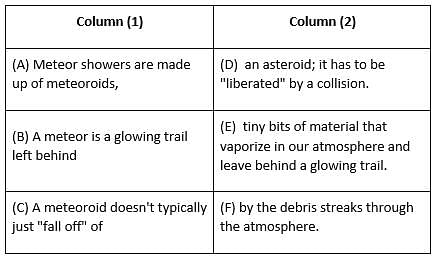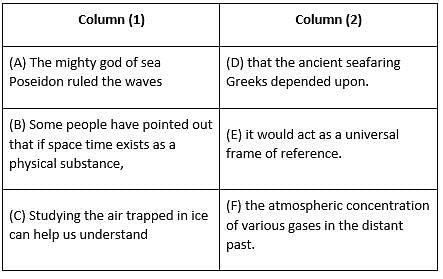English Language Test - 3 - Bank Exams MCQ
30 Questions MCQ Test IBPS RRB Clerk Mock Test Series & Past Year Papers 2024 - English Language Test - 3
Which of the phrases given below the sentence should replace the word/phrase that is underlined in the sentence to make it grammatically correct? If the sentence is correct as it is given and no correction is required, mark 'No error' as the answer.
None but I eventually turned up for the meeting.
Directions: In the following question, a sentence is given with four words marked as (A), (B), (C), and (D). These words may or may not be placed in the correct order. Four options with different arrangements of these words have been provided. Mark the option with the correct arrangement as the answer. If no rearrangement is required, mark option (5) as your answer.
Rakesh is going to hire(A) a packing company to move(B) his family’s facilitate(C) so his pregnant wife will not have to exert(D) herself.
| 1 Crore+ students have signed up on EduRev. Have you? Download the App |
Directions: Given below is a word, followed by three sentences that consist of that word. Identify the sentence(s) that express(es) the meaning of the word.
PARTY
A. His party won a landslide victory in the elections.
B. Let's have the party at my house.
C. We are still seeing a party between men's and women's salaries.
Direction: The given sentence is divided into four parts: A, B, C, and D. Choose the part that contains an error as your answer. If the sentence is error-free, mark E i.e. No error as your answer.
We chose our objects and our (A)/ places of memory, or, rather, the (B)/ spirit of the times decides what (C)/ is worth remembering. (D)/ No error (E)
Which of these should be the FIRST sentence after rearrangement?
Which of these should be the SECOND sentence after rearrangement?
Which of these pairs form consecutive sentences after rearrangement?
Which of these should be THIRD sentence after rearrangement?
Which of these should be FOURTH sentence after rearrangement?
In the sentence, certain words are in bold and numbered from A to E, which are the possible pairs to be interchanged. Choose the pair(s) of words which need to be interchanged to make the sentence grammatically correct and meaningful.
For (A)over fifty years, The Chronicles of Narnia have (B)canon the fantasy (C)genre to become part of the (D)transcended of (E)classic literature.
In the sentence, certain words are in bold and numbered from A to E, which are the possible pairs to be interchanged. Choose the pair(s) of words which need to be interchanged to make the sentence grammatically correct and meaningful.
As internet (A)penetration has (B)developing this past decade, especially in the (C)surged world, so have (D)attempts to switch off the (E)flow of information.
In the sentence, certain words are in bold and numbered from A to E, which are the possible pairs to be interchanged. Choose the pair(s) of words which need to be interchanged to make the sentence grammatically correct and meaningful.
The age of the remains (A)marks Central Java as Homo erectus’s final stand, and (B)confirms the species as the longest surviving human (C)ancestor by far, its presence (D)evolutionary across the (E)stretching tree for about 1.8m years.
In the sentence, certain words are in bold and numbered from A to E, which are the possible pairs to be interchanged. Choose the pair(s) of words which need to be interchanged to make the sentence grammatically correct and meaningful.
The last known (A)resting place of Homo erectus, one of the most (B)traced human ancestors and the first to walk fully (C)upright, has been (D) successful to a (E)floodplain near the longest river on the Indonesian island of Java.
The given question has one blank indicating that something has been omitted. Choose the word from the given options that could fit in the blank correctly.
He obeyed and sat across from her, nervously ____ in his seat several times under her gaze.
In the following question, two columns are given, containing three phrases each. A phrase from the first column may or may not connect with a phrase from the second column to make a grammatically and contextually correct sentence. There are five options, four of which display the sequence(s) in which the phrases can be joined to form a correct sentence. If none of the phrases make a correct sentence, mark ‘None of these’ as your answer.

In the following question, two columns are given, containing three phrases each. A phrase from the first column may or may not connect with a phrase from the second column to make a grammatically and contextually correct sentence. There are five options, four of which display the sequence(s) in which the phrases can be joined to form a correct sentence. If none of the phrases make a correct sentence, mark ‘None of these’ as your answer.

In the question given below, the sentence/part of the sentence is in bold. Five alternatives are given for the bold words. Choose the correct alternative that will improve the sentence or mark the option corresponding to it. Choose option 5 if no improvement is required.
The brother made her sister wept by accidentally breaking her toy.
In the question given below, the sentence/part of the sentence is in bold. Five alternatives are given for the bold words. Choose the correct alternative that will improve the sentence or mark the option corresponding to it. Choose option 5 if no improvement is required.
Let’s go to home and finish homework.
A sentence/part of the sentence is emboldened. Five alternatives are given to the emboldened part which will improve the sentence. Choose the correct alternative and choose the option corresponding to it. In case no improvement is needed, click the option corresponding to “no improvement required”
Britain’s Prime Minister has discovered the dates she will step down following the failure to deliver a proper exit from the EU for Britain.
Direction: Evaluate the following word, accompanied by three sentences containing it. Determine the sentence(s) that accurately convey the meaning of the given word.
Conflagration
A. The firefighters battled the conflagration until dawn, saving many homes.
B. During the debate, his single comment sparked a conflagration of responses from the audience.
C. She looked forward to the spring conflagration when all the flowers would bloom at once.
Which of the following pairs represent the THIRD and FOURTH sentences in the correct arrangement?
Which of the following is the introductory sentence after rearrangement?
Which of the following is the correct arrangement of the sentences?
Which of the following is the concluding sentence after rearrangement?
Which of the following is the SECOND sentence after rearrangement?
Directions: Below a statement has been divided into four parts. The part in bold is fixed and contains no error. Among the other parts, find the erroneous part. If there is no error, mark Option 5 as your answer.
Eating nothing beside (A)/ string cheese and celery (B)/ for a week to lose weight (C)/ is not very healthy (D)/. No error (E)
Directions: Below a statement has been divided into four parts. The part in bold is fixed and contains no error. Among the other parts, find the erroneous part. If there is no error, mark Option 5 as your answer.
One of my cousin (A)/ is coming over (B)/ from France with (C)/ his wife and daughter (D)/. No error (E)
Directions: Below a statement has been divided into four parts. The part in bold is fixed and contains no error. Among the other parts, find the erroneous part. If there is no error, mark Option 5 as your answer.
If she had (A)/ embarrassed me in front (B)/ of all my friends, I will (C)/ have hated her forever (D)/. No error (E)
Directions: Below a statement has been divided into four parts. The part in bold is fixed and contains no error. Among the other parts find the erroneous part. If there is no error mark option 5 as your answer.
Where happiness indicators were once used as (A) a basic to reform society, challenging the obsession with(B)/ money that G.D.P. measurement entrenches, they are increasingly(C)/ used as a basis to transform or disciplined individuals. (D)/ No error(E)
Directions: Below a statement has been divided into four parts. The part in bold is fixed and contains no error. Among the other parts find the erroneous part. If there is no error mark option 5 as your answer.
More recent reports highlights dangers (A)/ posed by adsorption of toxic chemicals(B) in the water and by plastic odors that(C) mimic some species’ natural food. (D)/ No error (E).
|
31 docs|49 tests
|
|
31 docs|49 tests
|

















